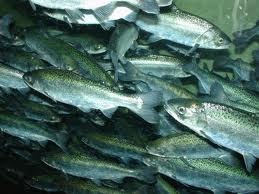
Every time we ride the ferry, we pass by Cannery Landing, the sight of the former Friday Harbor Packing Company. Founded in the late 1800s, the cannery thrived and became an important source of income for many of the island population.
We recently had the pleasure of hearing “Fish Tales” at the San Juan Historical Museum, stories from a lifetime of fishing, by John Wade and Terry Jackson. John’s dad was foreman of the cannery, and the family lived next door to it. At only 9 years of age, John started working at the cannery, and was “promoted” to work on the m/v Nyriad at age 12. His job was to stand in the engine room and listen for the Captain’s signals to go forward or reverse! Terry’s father founded a cannery a mile and a half away, in the area near Argyle Spit and the little town of Argyle, which we now know as Jackson Beach. The elder Mr. Jackson had a mink ranch in the valley, and had been buying fish heads and tails from Friday Harbor Packing Company to grind for mink food; he decided he could do better by buying, cleaning, and packing his own fish.

Both men worked as commercial fishermen in the area, competing with over 100 boats in the glory days of SJI fishing. Large corporations owned fish traps that were strung out across the west side of the island (where we now stand and watch whales just south of Lime Kiln State Park), but fortunately the traps were outlawed in 1934 when authorities recognized the massive depletion of fish and lack of River of Origin identification caused by the traps. (If you find those big eye hooks in the rock, John and Terry believe they are remnants of the fish traps.) Following that, purse seiners came in, increasing the haul as well as the competition for the prize salmon of the region. The men of these boats lived in “fish camps,” virtual tent villages, during the summer months. Old Camp, near the former Peter Lawson farm, and Kanaka Bay had prominent fish camps; in fact, there was even a grocery store at the Kanaka Bay camp.

All these fishing boats brought in thousands of pounds of fish to the canneries. Friday Harbor Packing Company, being the larger of the canneries, would run two or three lines eight hours a day, processing 15,000 – 18,000 of fish; at one time they employed nearly a thousand workers, many of them Chinese laborers. But during the high season, there would be hundreds of thousands of fish on the floor each day waiting processing – this in the days before the use of ice or any chilling process on the fish. John tells us the schools would take a break and the stores in town would close down so that everyone– men, women, and children – could work in the cannery and get those fish processed.


This was the economic boom for islanders, and the fish they canned was considered the “best pack.” With the canneries being so close to the source, the fish retained its high quality inside the can. Imagine the difference when the fish was motored eight hours without ice to be packed in Seattle. Local salmon was packed under the Salt Air and Carnation labels, but most of it bore the S&W label of the highest volume buyer, and the men estimate 80-90% of the end product was shipped to England.
According to John and Terry, The Friday Harbor Packing Company eventually went bankrupt because the new owner couldn’t get along with the local fishermen. They started selling their fish elsewhere, and the owner couldn’t buy enough fish to stay in operation. Meanwhile, Terry’s dad sold the Jackson Cannery to a man who still owns the property today. You can see it when you visit Jackson Beach, and there’s an interesting history behind the erection of that structure – but that’s another story.
For more information on original founders of the Friday Harbor Canning Company, see http://saltwaterpeoplehistoricalsociety.blogspot.com/2011/09/friday-harbor-cannery-was-swift-success.html.
Our thanks to San Juan Historical Museum for providing the opportunity to hear priceless tales about the history of our island.

